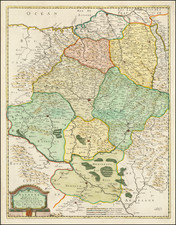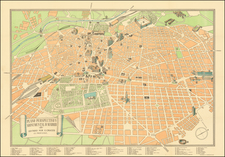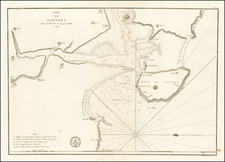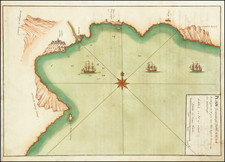Fine view of the Bay of Vigo (oriented with east at the top of the view), depicting the Battle of Rande (Vigo Bay) in October 1730, during the War of Spanish Succession, by Peter Fehr.
The Battle was fought on October 23 and 24, 1702, at the outset of the War of the Spanish Succession. The engagement followed an Anglo-Dutch attempt to capture the Spanish port of Cádiz in September, 1702, in an effort to secure a naval base in the Iberian Peninsula. From this station the Allies had hoped to conduct operations in the western Mediterranean Sea, particularly against the French at Toulon.
While the attempt to take Cadize proved a disaster and as Admiral George Rooke retreated home in early October, he received news that the Spanish treasure fleet from America had entered Vigo Bay in northern Spain. Philips van Almonde convinced Rooke to attack the treasure ships, despite the lateness of the year and the fact that the vessels were protected by French war ships
The engagement was an overwhelming naval success for the British-Dutch Alliance. The entire French escort fleet, under the command of Château-Renault, together with the Spanish galleons and transports under Manuel de Velasco, were either captured or destroyed. Yet because most of the treasure had been off-loaded before the attack, capturing the bulk of the silver cargo had eluded Rooke. Nevertheless, the victory was a welcome boost to Allied morale and had helped persuade the Portuguese King, Peter II, to abandon his earlier treaty with the French, and join the Grand Alliance.
The Spanish naval losses resulted in a total dependence on the French navy to keep up communications with the Americas. However, the Spanish government felt no financial blow, as the Crown owned only two of the three large galleons, and none of the trading vessels. Those who suffered most, not just from the losses of the ships but also from the immense merchandise on board (pepper, cochineal, cocoa, snuff, indigo, hides, etc.) were the private traders.
The military success was at best a twist of irony. The news that the treasure fleet had got safely to Vigo was initially the cause of celebration for the merchants of Holland, but the subsequent reports of the battle were received with mixed feelings in Amsterdam as the wealth captured or destroyed belonged as much to the English and Dutch traders as it did to the Spanish. What the Spanish government did own was the silver, most of which had already been unloaded from the ships before the Allied attack, and was ultimately deposited in the castle of Segovia.
The Allies, therefore, did not capture as much silver for themselves as was often supposed. The Master of the Mint, Isaac Newton, stated in June 1703, that the total metal handed in to him by that date was estimated at a value of just £14,000. In February 1703, Philip V issued a decree, by way of reprisal, to confiscate all the silver that had come with the treasure fleet belonging to the English and Dutch, totalling four million pesos. In addition, the King decided to borrow two million pesos from what had come for the Spanish traders and the Consulate of Seville. In total, Philip managed to keep nearly seven million pesos, representing over half the silver from the fleet, amounting to the biggest sum in history obtained from the American trade by any Spanish king. The result was an immense financial windfall for Philip V.










![[ Spain & Portugal ] Tabula II Europae (Title on Verso)](https://storage.googleapis.com/raremaps/img/small/103197.jpg)


![[Castille, Spain] Il Regno di Castiglia Nuova . . . 1696](https://storage.googleapis.com/raremaps/img/small/64863.jpg)
